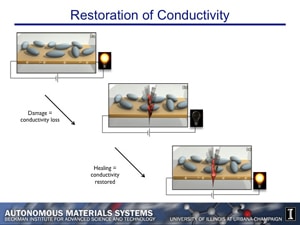
A team of University of Illinois engineers has developed a self-healing system that restores electrical conductivity to a cracked circuit in less time than it takes to blink. Led by aerospace engineering professor Scott White and materials science and engineering professor Nancy Sottos, the researchers published their results in the journal Advanced Materials.
As electronic devices are evolving to perform more sophisticated tasks, manufacturers are packing as much density onto a chip as possible. However, such density compounds reliability problems, such as failure stemming from fluctuating temperature cycles as the device operates or fatigue. A failure at any point in the circuit can shut down the whole device.
Most consumer devices are meant to be replaced with some frequency, adding to electronic waste issues, but in many important applications – such as instruments or vehicles for space or military functions – electrical failures cannot be replaced or repaired.
The self-healing system requires no human intervention or diagnostics, a boon for applications where accessing a break for repair is impossible, such as a battery, or finding the source of a failure is difficult, such as an air- or spacecraft.
“In an aircraft, especially a defense-based aircraft, there are miles and miles of conductive wire,” Sottos said. “You don’t often know where the break occurs. The autonomous part is nice – it knows where it broke, even if we don’t.”






